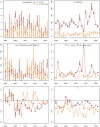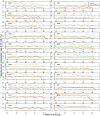Sustainable fishing harvest rates for fluctuating fish and invertebrate stocks
- PMID: 39325706
- PMCID: PMC11426504
- DOI: 10.1371/journal.pone.0307836
Sustainable fishing harvest rates for fluctuating fish and invertebrate stocks
Abstract
Ecological theory predicts fluctuations, such as oscillations and instabilities, in populations whose dynamics can be represented by discrete-time surplus production models, whenever the intrinsic rate of population growth (r) is too high. Many fished stocks may have sufficiently high r to undergo fluctuations under fishing. The maximum sustainable yield (MSY) is the fishing harvest rate concept that underlies United Nations Sustainable Development Goals and much of national fisheries administration around the world and yet in fluctuating stocks the MSY does not exist. This is because MSY's existence necessitates stable zero growth rates and in fluctuating stocks the growth rate switches from positive to negative over regular or irregular cycles, never staying put at zero. A more general surplus production concept is the total latent productivity (TLP). TLP averaged over years of negative and positive productivity has been proposed as a sustainable annual harvest rate for fluctuating stocks. We tested this theory assessing two harvested octopus populations inhabiting the Yucatan Peninsula with a 22-years time series of data, and a two-stages stock assessment methodology, with time-varying parameters at both stages. We find that parameters of the population dynamics changed in both species, dividing the time series in two periods, leading from single-point equilibrium to fluctuating dynamics in one species and increased amplitude and amplitude variability in the other species. These results mean that management based on the MSY would lead to overfishing and collapse of the two octopus stocks, as shown by stochastic projections. Conversely, the average TLP yielded much lower and realistic annual harvest rates, closer to actual landings over the 22-years period. We conclude that average TLP is the correct sustainable harvest rates for fluctuating stocks, which may include cephalopods, other invertebrates and small pelagic fish. This more general concept of surplus production needs to be incorporated in multilateral and national fisheries management policies to avoid overfishing stocks that have fluctuating population dynamics.
Copyright: © 2024 Poot-Salazar et al. This is an open access article distributed under the terms of the Creative Commons Attribution License, which permits unrestricted use, distribution, and reproduction in any medium, provided the original author and source are credited.
Conflict of interest statement
The authors have declared that no competing interests exist.
Figures






References
-
- Methot R. D., Wetzel C. R. Stock synthesis: A biological and statistical framework for fish stock assessment and fishery management Fisheries Research 142, 86–99, 2013. doi: 10.1016/j.fishres.2012.10.012 - DOI
-
- Skonhoft A., Gong P. Maximum sustainable yield harvesting in an age-structured fishery population model Natural Resource Modeling, 29, 610–632, 2016. doi: 10.1111/nrm.12118 - DOI
-
- Winker, S., Mourato, B., Chang, Y. Unifying parameterizations between age-structured and surplus production models: an application to Atlantic white marlin (Kajikia albida) with simulation testing Collective Volume of Scientific Papers ICCAT, 76, 219–234, 2020.
-
- Smith, T. P., Sissenwine, M. P. Fishery Management In J. H. Steele (Ed.), Encyclopedia of Ocean Sciences (pp. 1014–1023).
-
- Earle M. Maximum sustainable yield in the EU’s Common Fisheries Policy—a political history ICES Journal of Marine Science 78, 2173–2181, 2021.
MeSH terms
LinkOut - more resources
Full Text Sources

